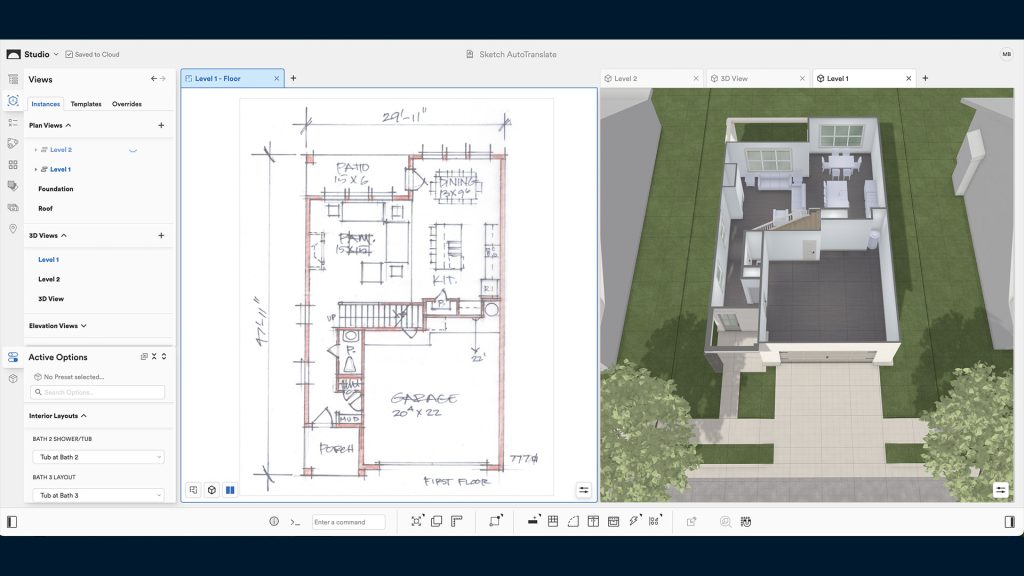In the emerging world of BIM 2.0, there will be generic new BIM tools and expert systems, dedicated to certain building types. Higharc is a cloud-based design solution for US timber frame housing. The company just demonstrated impressive new AI capabilities.
While AI is in full hype cycle and not a day passes without some grandiose AI claim, there are some press releases that raise the wizened eyebrows at AEC Magazine HQ.
North Carolina-based start-up, Higharc, has demonstrated a new AI capability which can automatically convert 2D hand sketches to 3D BIM models within its dedicated housing design system. This type of capability is something that several generic BIM developers are currently exploring in R&D.
Higharc AI, currently in beta, uses visual intelligence to auto-detect room boundaries and wall types by analysing architectural features sketched in plan. In a matter of minutes, the software then creates a correlated model comprising all the essential 3D elements that were identified in the drawing – doors, windows, and fixtures.
Everything is fully integrated with Higharc’s existing auto-drafting, estimating, and sales tools, so that construction documents, take-offs, and marketing collateral can be automatically generated once the design work is complete.
In one of the demonstrations we have seen, a 2D sketch of a second floor is imported, analysed and then automatically generates all the sketched rooms and doors, with interior and exterior walls and windows. The AI generated layout even means the roof design adapts accordingly. Higharc AI is now available via a beta program to select customers.
Marc Minor, CEO and co-founder of Higharc explains the driving force behind Higharc AI. “Every year, designers across the US waste weeks or months in decades-old CAD software just to get to a usable 3D model for a home,” he says.
“Higharc AI changes that. For the first time, generative AI has been successfully applied to BIM, eliminating the gap between hand sketches and web-based 3D models. We’re working to radically accelerate the home design process so that better homes can be built more affordably.”
AI demo
In the short video provided by Higharc, as seen below, we can see a hand drawn sketch imported into the Autolayout tool. The sketch is a plan view of a second floor, with bedrooms, bathrooms and stairs with walls, doors and windows indicated. There are some rough area dimensions and handwritten notes, denoting room allocation type. The image is then analysed. The result is an opaque overlay, with each room (space) tagged appropriately, and a confirmation of how many rooms it found. There are settings for rectangle tolerance, minimum room areas. The next phase is to generate the rooms from this space plan.
We now switch to Higharc’s real-time rendered, modelling and drawing environment, where each room is inserted on the second floor of an existing single floor residential BIM model, where walls, windows, doors and stairs are added and materials are applied. This is simultaneously referencing an image of the sketch. The accurate BIM model has been created, combining traditional modelled with AI sketch-to-BIM generation.
What is Higharc?
Founded in 2018, Higharc develops a tailored cloud-based BIM platform, specifically designed to automate and integrate the US housing market, streamlining the whole process of design, sales, and constructing new homes.
Higharc is a service sold to home builders, that provides a tailored solution which integrates 3D parametric modelling, the auto creation of drawings, 3D visualisations, material quantities and costing estimates, related construction documents and planning permit application. AEC Magazine looked at the development back in 2022.
The company’s founders, some of which were ex-Autodesk employees, recognised that there needed to be new cloud-based BIM tools and felt the US housing market offered a greenfield opportunity, as most of the developers and construction firms in this space had completely avoided the BIM revolution, and were still tied to CAD and 2D processes. With this new concept, Higharc offered construction firms easy to learn design tools, which even prospective house buyers could use to design their dream homes. As the Higharc software models every plank and timber frame, accurate quantities can be connected to ERP systems for immediate and detailed pricing for every modification to the design.
The company claims its technology enhances efficiency, accelerating a builder’s time to market by two to three times, reducing the timeline for designing and launching new plots by 75% (approximately 90 days). Higharc also claims that plan designs and updates are carried out 100 times faster than with traditional 2D CAD software.
To date, Higharc has raised $80 million and has attracted significant investment and support from firms such as Home Depot Ventures, Standard Investments, and former Autodesk CEO Carl Bass. The company has managed to gain traction in the US market and is being used to build over 40,000 homes annually, representing $19 billion in new home sales volume.
While the company’s first go to market was established house building firms, it has used money raised to expand its reach to address those who want to design and build their own homes. The investment by Home Depot would also indicate that the system will integrate with the popular local building merchants, so self-builders can get access to more generic material supply information. The company also plans to extend the building types it can design, eventually adding retail and office to its residential origins.









